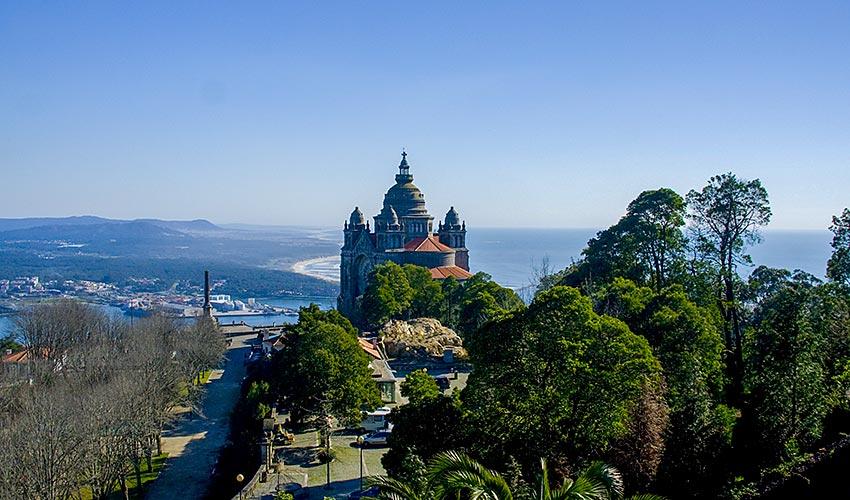Situated at the mouth of the Lima river, between the ocean and the mountains, the charming city of Viana do Castelo is steeped in tradition. Historically, the city was a crucial point of departure during the Age of Discovery, when many Portuguese explorers embarked to discover the unknown world.
Today, Viana do Castelo is a lively fishing port, renowned for its compelling architecture, featuring Manueline and Renaissance influences as well as innovative contemporary design. Below the hills of Santa Luzia, the narrow, winding streets are lined with beautiful palaces and houses constructed over the centuries. Visitors will also enjoy the beautiful Cabedelo beach across the Lima estuary.
Throughout the Minho province, many religious festivals and popular fairs are held throughout the year. Festivities in Viana do Castelo culminate in the middle of August with the celebration of the Romaria de Nossa Senhora d’Agonia, which dates back to the 18th century. For three days, the streets are filled with people enjoying the parade of floats, towering puppets and colourful local costumes, as well as traditional music and food.
The nearby town of Ponte de Lima boasts a fine Roman bridge, a lively market and neighbourhoods of impressive rural mansions and old cottages. Along the Minho river, which separates Spain from Portugal, interesting border towns include Caminha, Valença, Monção and Melgaço. Other places to visit include the quaint towns of Paredes de Coura, Arcos de Valdevez and Ponte da Barca. Every two years, Vila Nova de Cerveira hosts a contemporary arts festival.
Places to see
Igreja da Misericórdia (Misericórdia church) (Viana do Castelo)
This unique 18th century church is composed of an illustrious combination of Roman archways, Renaissance balconies and intricately carved pillars. The ornate interior decoration features baroque and Rococo influences including gilded engravings, sculptures and paintings. Some of the finest Portuguese azulejo panels, representing passages from the Bible, can be found in this church.
Citânia de Santa Luzia (Santa Luzia citadel) (Viana do Castelo)
The ruins of a fortified Iron Age village can be found on the outskirts of Viana do Castelo, on top of Santa Luzia hill. Featuring unique polygon-shaped stone houses, successful excavations have shown that the Romans occupied this village until the 5th century. This citadel has also been classified as a national monument.
Parque Nacional da Peneda-Gerês (Peneda-Gerês National Park)
The unspoilt natural beauty of Portugal’s only national park spans over 700 square kilometres (270.3 square miles). Visitors can trek through the wilderness and enjoy breathtaking scenery, from high peaks and wooded valleys to waterfalls and calm rivers ideal for water sports. The park boasts a wide variety of fauna and flora as well as tiny remote villages.
Termas de Peso (Peso Spa) (Melgaço)
Situated in a forested green valley filled with the sound of running water, this spa is a peaceful resort recognised for its therapeutic potential. The rich mineral waters have been used in the treatment of many ailments since the late 1800s, including obesity, diabetes and high cholesterol. Extending over 2 hectares (4.9 acres), the resort also contains a camping site and bungalows, as well as a mini-golf course, tennis court and café.
Castelo de Melgaço (Melgaço Castle) (Melgaço)
One of the most important military bastions along Portugal’s northern border, this Romanesque castle was built in the 12th century and later fortified by a wall connecting it to the city. The only remains of the medieval fortifications are the keep of the castle, part of the fortress, three towers and the northern and western doors. The castle was classified as a national monument in 1910 and the keep has been transformed into a museum.
Centro Tesal Termas de Monção (Monção Spa) (Monção)
This luxurious modern spa is dedicated to traditional thermal treatments, boasting over 5,000 m2 (53,820 square feet) of facilities. The warm, sulphurous waters are believed to have healing properties to treat a wide range of disorders. From the superb hydrotherapy circuit and massage to specific treatments focusing on relaxation, stress relief and weight loss, visitors will enjoy the beautiful location surrounded by nature.
Núcleo Megalítico do Mezio (Megalithic Nucleus of Mezio) (Arcos de Valdevez)
This prehistoric site is composed of a dozen megalithic monuments which were used as burial sites during the the Copper Age by local shepherds and famers. Also known as Antas da Serra do Soajo, this site is important not only for its archaeological artefacts, but also valuable as a unique example of prehistoric funerary spaces.
Castelo de Santa Cruz (Santa Cruz Castle) (Arcos de Valdevez)
Overlooking the village of Vila Fonche, this strategically-positioned Romanesque castle was one of the first infrastructures to support human settlements in this area. Archaeologists have discovered defensive features including evidence of protective walls and the foundations of a keep. The castle was probably abandoned around the mid-13th century.
Mosteiro de Ermelo (Ermelo’s Monastery) (Arcos de Valdevez)
Situated near the Lima river, this former Benedictine monastery was built in the 13th century and later adopted by Cistercian nuns and monks. The temple was eventually converted to a parish church. Despite suffering damage over time, the monastery’s unique architecture and cultural heritage has been acknowledged and it was classified as a national monument in 1977.

 English
English  Português
Português  Deutsch
Deutsch 



